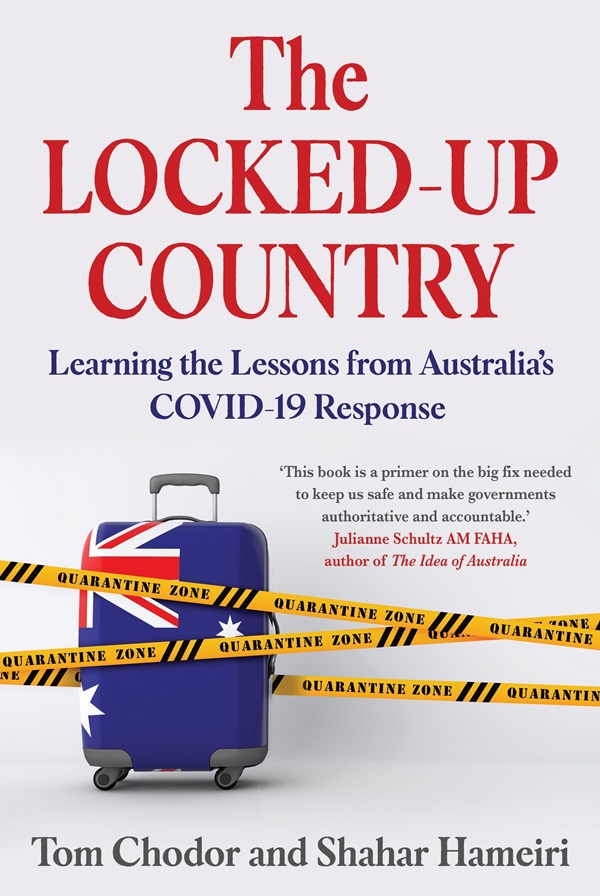Australia’s Albanese government recently announced an inquiry into the Commonwealth government’s Covid-19 response. While such an inquiry is welcome, the announcement was immediately criticised for breaking Labor’s election promise to convene a Royal Commission. The inquiry’s terms of reference were also criticised for excluding policies enacted by state and territory governments, notably lockdowns and border closures. Opposition critics have also implied that Albanese aimed to shield Labor state and territory governments, while directing attention to the Morrison government’s performance.
Our newly published book, The Locked-Up Country, argues that such squabbling over particular governments’ actions is missing the point. The response to the Covid-19 pandemic revealed the inherent pathologies of Australia’s “regulatory state” – created over several decades of Labor and Coalition governments. Unless the deeper sources of these pathologies are recognised and addressed, the same problems will keep emerging in future crises.

Donald Horne famously called Australia the “lucky country”, a term he used ironically. Horne scorned Australia’s “second-rate” political and business elites and fretted that the country’s luck would run out. Australia’s pandemic response demonstrates the enduring truth of his thesis. As luck would have it, the initial decision to close borders and impose lockdowns eliminated local transmission of the coronavirus. But Australia’s luck couldn’t last forever. As the pandemic dragged on, policy failures in key planks of the pandemic response, notably hotel quarantine and the vaccination campaign, began to mount. Since governments continued to rely on closed borders and lockdowns to cover these failures, Australia turned from the lucky country into the “locked-up country” – closed off to the world and fragmented along state and territory borders, with its major cities enduring repeated and extended lockdowns.
These failures have deeper roots. Following the Second World War, governments in Australia ruled via hierarchical, “command-and-control” structures to implement increasingly ambitious policy agendas, including full employment and a widening range of social services. As post-war boom turned to gloom in the 1970s, many blamed the crisis on an over-burdened State, caught between unsustainable promises and a faltering economy. Hence, from the 1980s, Australian leaders began pursuing reforms that would fundamentally change the nature of policymaking. Often called “neoliberalism” (or “economic rationalism” in Australia), these policy and institutional changes were not motivated primarily by some naïve belief in “free markets”; their aim was to reduce popular influence over, and expectations of, the State – the organisations, processes and relations at all levels involved in the formulation and implementation of public policy.
In practice, this often involved creating an arms-length relationship between elected government and those developing and implementing policy, allowing leaders plausible deniability for policy decisions and their outcomes. Unelected agencies, such as the Reserve Bank of Australia, were made autonomous of government; important policy functions were outsourced to private companies and consultants; state-owned companies were privatised; and social services were marketised. Rather than direct these various agencies, the role of governments has mainly shifted to guiding, incentivising and coordinating them – the “regulatory state”. Australian federalism changed too, from devolution to “regulatory federalism”, whereby relations between the Commonwealth and state governments fragmented into issue-specific networks that the Council of Australian Governments attempted to coordinate.
These changes created deep pathologies, which the pandemic response brutally exposed, restricting leaders’ options and constraining their capacity to successfully implement policy. They have also created a political climate in which avoiding responsibility became pervasive.
The fragmentation of governance has undermined central agencies’ capacity for direct action and blurred lines of control. Instead of clear hierarchies delineating control and responsibility, we get complex multi-layered structures for governing many issues, where it’s hard to ascertain who is in charge, if anyone, and what authority they may have over others. Though elaborate plans often exist, the underlying capacities to back them up are lacking. In an emergency, absent capacities cannot be conjured, so plans are scrapped for ad hoc measures.
This was plain to see during the pandemic. Lockdowns and closed borders were nowhere mentioned in Australia’s pandemic planning. They were introduced because it quickly became clear that Australia couldn’t implement its test, trace and quarantine plans. With the public increasingly panicking and other Western countries implementing lockdowns, the unthinkable rapidly became reality. Lockdowns and closed borders also had the advantage of being relatively simple to implement. More sophisticated policy responses – think repeated hotel quarantine breaches or the vaccination “strollout” – failed repeatedly, as we document in the book.
Fragmented regulatory governance arrangements also undermine accountability, permitting endless blame-shifting and buck-passing – between the federal and state governments, and to private contractors and expert bodies: this is precisely why they were created. Indeed, during the pandemic, blame-shifting and buck-passing abounded. While then-prime minister Scott Morrison copped considerable flack for his efforts to blame others, he was far from alone among political leaders for doing so. Not much has changed since, either, as we can glean from the fights erupting around the Covid-19 response inquiry.
Australians have noticed these pathologies. The growing loss of trust in political leaders and parties, and in democratic institutions, is long-documented, hitting an all-time low just before the pandemic. While the early, and unexpected, success of pandemic control measures temporarily restored public support, this proved short-lived. This is not surprising, since opportunities for meaningfully affecting public policy via political engagement have narrowed considerably.
Indeed, while capacities can be built, for example by establishing an Australian Centre for Disease Control, this must be coupled with efforts to increase the Australian State’s democratic responsiveness. Otherwise, any number of public inquiries would fail to address the problems exposed by Australia’s pandemic response.
Tom Chodor is Senior Lecturer in Politics and International Relations at the School of Social Sciences, Monash University. Shahar Hameiri is Professor of International Politics at the University of Queensland. Their new book is The Locked-up Country published 28 October (UQP).

